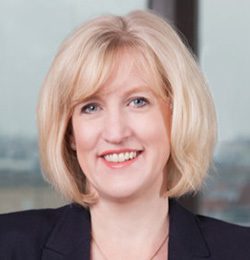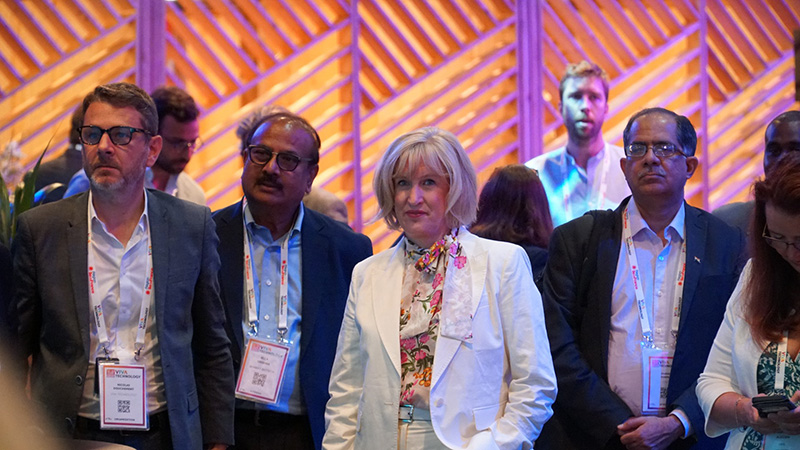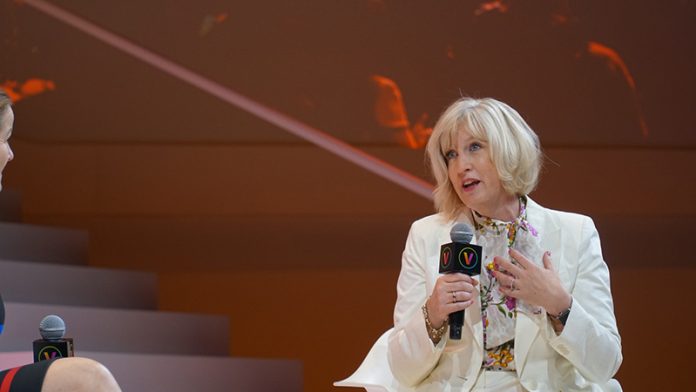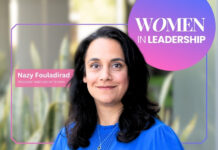By Emil Bjerg, journalist and editor of The European Business Review
Recently we had the privilege to sit down with Julie Teigland, EY’s Managing Partner for Europe, Middle East, India and Africa, for a talk about the green revolution, technological possibilities, and why she remains an optimist on behalf of both Europe and the climate in a period of intertwining crises. Teigland, who was featured in Fortune’s 2021 list of the most powerful women in the world, also shared with us her career path and her advice for young professionals.
You have a really impressive career. Since 2019 you’ve been EY’s Managing Partner for Europe, Middle East, India and Africa, leading more than 115,000 employees. Can you briefly walk us through your professional journey?
“I think I probably did not have such a spectacular journey as you’re thinking, to be honest,” Julie Teigland says in a friendly, humble fashion.
Teigland shares that she started in the financial consultancy Anderson in 1990, working with internal accounting before moving to tax for 12 years at the same company. As a senior manager, she decided it was time to “see the other side” and started working for a real estate developer, taking part in significant urban developments across Europe with the new iteration of Potsdamer Platz in Berlin as a highlight, among others.

She then joined EY, the top-tier accounting firm formerly known as Ernst & Young, where she was responsible for building different practices in a diverse set of areas such as human capital and growing audit clients, as well as working with entrepreneurs and fast-growing businesses around Europe. She then went on to lead EY’s activities in Germany, Switzerland, and Austria before going on to lead their activities in all of Europe, the Middle East, India, and Africa.
Once again humbly, Teigland adds: “I wish I could tell you really fantastic, amazing things. I was not a rocket scientist on the way. But I’m really proud that I’ve seen several parts of the business.”
Tech, sustainability, and current global affairs
I’d like to talk to you about tech and sustainability from the perspective of the current global situation.
In this year’s VivaTech Paris, you participated in a star-studded panel, addressing “How Can Tech Fuel the Green Revolution?”. Can you tell us a bit about what the experience was like? How optimistic are you about the future as we shift toward a model of more sustainable growth?
“VivaTech was great and doing the panel was fantastic,” Julie Teigland says of the panel, where she was in conversation with Daniel Schmid from SAP, Maurice Levy from Publicis, and Louise Koch from Dell.
“I’m a big believer in the green revolution. I really think that unless we all embrace the idea that sustainability is not just good for the planet, it’s also good for business, this isn’t going to go very far. I think too many times our sustainability conversations are focused on the output, which is the reporting, and not the input, which is the change in strategy.”
Julie Teigland describes how talking to the other panellists from VivaTech about what they’re each doing in their companies confirms her enthusiasm for a green future. She mentions that Dell has gone through a dramatic change when it comes to the circular economy, as well as lowering emissions from production. She mentions how SAP works with creating software that can capture sustainability data throughout the entire value chain; and how Publicis works with driving sustainability all the way from the board down. “They’re all embedding sustainability in their strategy,” she says.
“I’m convinced if more companies move in that direction, we’re going to see an increase, not only in innovation but equally in jobs and opportunities across all of our countries.”
Teigland is equally enthusiastic about the potential of ESGs. “We have to get more people to understand that ESG is not just a code word, it’s not just a buzzword, it’s really about the action we’re driving from a strategic perspective.” Teigland adds that she sees ESGs as more than just regulation, but rather something driving long-term value.
“We’ll get there,” she says, with reference to the goals set for sustainable growth, certain and confident.
I really appreciate that optimism.
“We need it!”
I’m wondering if you can give me an optimistic answer to the next question, as well. It seems that many countries had just reached sufficient levels of immunity from COVID-19 when Russia invaded Ukraine. At the same time, we’re facing historical levels of inflation. This happens against a backdrop of general scientific consensus that we need immediate global action to avoid extreme temperature hikes.
Do you see these crises as simply holding back the green transition or are there some positive side effects in this global landscape of intertwining crises when we’re talking about the green transition?
“I think the mission since COVID-19, and probably accelerated by the Ukraine war, is to map dependencies. Every company and every government needs to map dependencies, and I think we have started to do that. I think part of what Europe has realised is their dependence on Russia for energy and their need to move off that dependency. And I think that will accelerate the green transition tremendously.”
After starting on an optimistic note, Teigland talks about the negative impact of the current situation: “But I also know that the countermeasure for companies and their approach to long-term value in dealing with volatility is to take short-term measures. And you see these short-term measures both in corporate action as well as in government action.”
As an example, she mentions that the German government is currently discussing putting three coal power plants back in production to balance out energy for the rest of the year.
Teigland uses the playground game Bunny Hop – jumping two steps forward and one step back – as a metaphor for the current situation of trying to move forward with sustainability initiatives in a complicated situation of energy dependencies and intense geopolitical struggles.
“I think the Ukraine crisis and inflation will force us to take two steps forward and one step back. We’re going to have to jump, and we’re going to have to jump high. How do we get sustainable energy? How do we release the dependencies we have on Russia? How do we map the supply chain dependencies we have and start to get rid of some of those to move forward to a greener, safer future?”
Teigland talks about how the current volatility and inflation will force leaders to take short-term tactical measures that might not be what we would like to see as a part of the green revolution, but are necessary to keep the pace and the momentum in the long term.

“That’s how I’ve tried to phrase it and to get CEOs to think about it, because I don’t want us to lose the momentum we have in the green revolution. I want us to understand that there are some economic matters in front of us we have to deal with while we’re on that longer-term journey.”
“I really believe that the biggest risk is that we’re going to get lost in this volatility that’s going to grow over the next 12 months. That we get lost and lose track of the long-term goal. I don’t want us to do that. I think everyone is with us on that, which is why I’ve called it “the Bunny Hop” – two steps forward and a half-step back – as we’re trying to compensate for some of those tactical measures.”
So, a realistic optimist on this matter?
“Yes, a realistic optimist,” Teigland laughs, and then gets more serious. “Not everything can be green, but I think we’re moving in the right direction and I do think people understand – frankly, the heat wave across Europe tends to reinforce that – it can’t stay the way it’s been, we’ve got to change.”
And these heat waves have become annual reminders every summer…
“Yeah, and it’s important we have these reminders that we have work to do.”
The European Attractiveness Report – technology and sustainability as key to investments
EY has recently published its latest European Attractiveness Report, which you’ve been co-authoring. It showed that one of the most significant determinants of foreign direct investment in Europe is the level of technological adoption. Fifty-six per cent of investors believe that Europe is more attractive than other regions regarding technology-related factors. Why do you think that is?
“I think that’s because of the talent we have here. Europe has two things to offer: great infrastructure and talent that are specifically educated and have the necessary technological skills.”
“So when you think about where you want to invest, you ask: what’s my infrastructure like? What are the people like? Are they going to take up on technology? How are they going to leverage it? Do they have the right skills? And if I invest in technology, will I be able to protect it intellectually? Europe provides a really good basis for that and that makes it a key destination as a result. It pays off for Europe to invest in this protection.”
Teigland mentions that, while there are an enormous number of start-ups in Europe, there is a tendency for them to move to the US when they reach a certain size. As she says: “I feel like when they start to scale, they like to move across the ocean.” There’s a challenge, Teigland says, in “keeping this investment inside Europe”.
She sums up: “I think we have stable IP. We have great start-ups. I want to make sure, when it comes to scaling, that we have enough opportunity in Europe. We’re getting better – there’s more work to do.”
In the same report, 98 per cent of large businesses say environmental sustainability is either critical or somewhat important to their investment strategy. How would you advise companies to respond to this figure?
“It just goes to show that sustainability is really becoming a key differentiator in the market. And, frankly, it’s not only a differentiator on the customer side, it’s also a differentiator when it comes to financial institutions and corporates looking for liquidity. More and more investors and bankers are taking sustainability and meeting ESG metrics as an important factor, simply because their funds are also equally restricted in that fashion. So if companies aren’t addressing sustainability at the top of their agenda from a strategic point, I do feel like they will be continually squeezed over the next two years.”
Julie Teigland goes on to talk about the EU’s “Recovery and Resilience Plan”. “Across Europe, there’s far more investment available for sustainability initiatives than there’s ever been before. Thirty-seven per cent of the funding from the recovery fund is really focused on the green transition. It’s huge – billions available to companies! They’d be crazy not to use it.”
Career advice for young professionals
So, we started from the perspective of your professional journey. Out of personal curiosity, I want to ask you, what advice would you give to young professionals who want to create an exciting career and do something good for the world?
Teigland shares two pieces of advice, one about allowing oneself to take career risks, and the other on how to think of experiences as building blocks to have an impact and leave a legacy.
“Take a few risks. I took a lot of risks. Changing from internal to tax to audit. Not a lot of people take risks in their career.”
Teigland says further that she’s worked in different countries and has studied abroad. She has changed jobs and areas of expertise. She encourages young people, who she says don’t have so much to lose, to take some risks, too.
The second piece of advice she shares is about gaining experiences and seeing those experiences as building blocks. Teigland talks about her career as a series of experiences, having one position for three years, another one for four years, and ultimately becoming a career of 30 years in professional services.
“It’s based on a series; nothing is tied down forever. I think our careers of the future will be based on that – lots of building blocks, individual experiences that come together to build a mosaic. And the piece that holds it together, I think, is the purpose that drives you. What do you want to do? Where do you want to have an impact? I wanted to leave a legacy. I still do. I want this firm to be better off in the future. I believe at the end of my career, I will have contributed to shaping professional services. That’s where I would like to have an impact, and that’s what kind of knits my mosaic together.”
She sums up her advice: “Try to put your purpose ahead of a number of experiences and be bold enough and brave enough to just jump in the cold water – you’re going to be fine. It’s going to be another experience, you’re going to learn like hell and then move on to the next one. I’m sure there are a million other ways to build a career, but that one has worked for me and it gives people a lot of chances.”



































